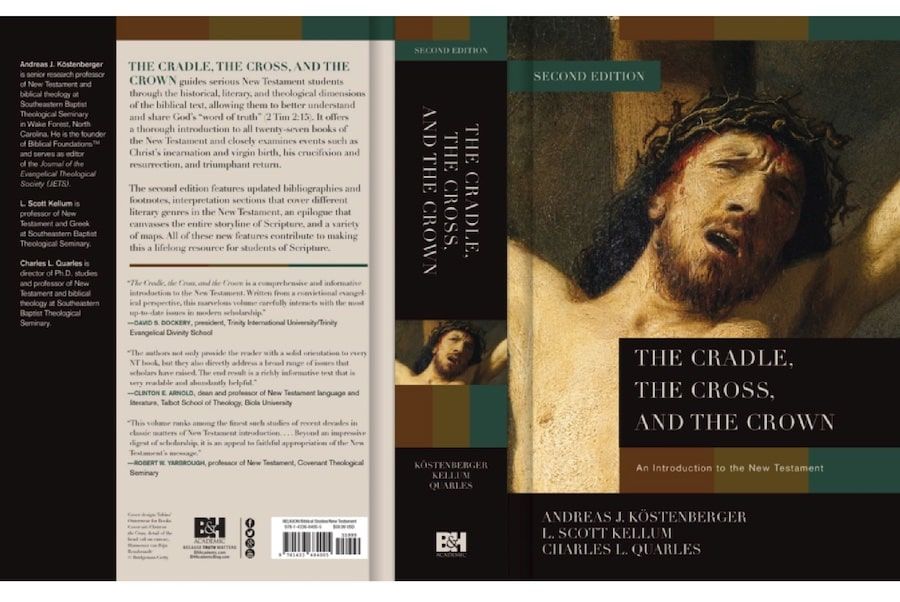The Cradle, the Cross, and the Crown — NT Introduction
This New Testament introduction offers a solid, conservative, evangelical viewpoint. It addresses modern issues of critical scholarship.

Any serious Bible student should have at least one good New Testament Introduction. Before 2009, conservative evangelical Christians had a few choices.
- New Testament Introduction (Revised Fourth edition) by Donald Guthrie was published in 2000. Originally published in 1961, this remains a terrific New Testament Introduction from a conservative, non–critical view.
- An Introduction to the New Testament (Second edition) by D.A. Carson and Douglas Moo was published in 2005. This introduction addresses some of the more popular critical theories of the New Testament, and it is one of the most popular NT introductions in many seminaries today.
- Raymond Brown’s Introduction to the New Testament, published in 1997, is more appropriate for academic scholars. Brown is Catholic, and his introduction is more open to critical views.
Today, we have a new addition. Andres J. Kostenberger, L. Scott Kellum and Charles L. Quarles, seminary professors from Southwestern Baptist Theological Seminary, have authored a terrific introduction to the New Testament. Originally published in 2009, this second edition was updated in 2016. If you are looking for your first New Testament introduction, I recommend The Cradle, The Cross, and the Crown without reservation.
Format of The Cradle, The Cross, and the Crown
Sitting over 1100 pounds, this reference work is adequate for Bible scholars. Yet, it is accessible for most laymen. Each chapter begins with a summary page entitled “Core Knowledge.” Three paragraph summarizes the (1) basic knowledge, (2) intermediate knowledge, and (3) advanced knowledge.
Many of us can read through the entire introduction focusing on the basic knowledge material. Seminary students might focus on all the material including the advanced knowledge topics.
The book is divided into 5 section.
- Part One devotes two chapters covering the basic theology of the Scriptures and the historical, political, religious and cultural background of the New Testament time period.
- Part Two covers the life of Jesus and each of the four New Testament gospels.
- Part Three covers the book of Acts and Paul’s 13 epistles.
- Part Four covers the general epistles and the book of Revelation.
- Part Five devotes two chapters covering the unity and diversity of the New Testament and a summarized story of Scripture as a whole.
The book includes a 30 page glossary and three indexes. One index lists all the names of the New Testament. Another index gives a list of topical subject. The third index is a scriptural index. The glossary and indexes adds to the usability of the hardback version.
Content of The Cradle, The Cross, and the Crown
The updated second edition is the most modern conservative New Testament introduction available today. The included bibliography is current and invaluable; in fact, the bibliography alone may be enough for some to purchase this updated volume.
Part 1: Introduction
The first chapter is a great introductory chapter covering the canon of the Scripture, the doctrine of inspiration and inerrancy, and issues of transmission and translation of the New Testament.
The second chapter covers the different ruling periods of Palestine during the Second Temple era. The authors walks the reader starting from the Babylonians, Persian and Grecian rule. It continues until the Roman period from 63 BC to AD 70.
Part 2: Jesus and the Gospels
Chapter 3 covers the relationship of the Synoptic gospels and evaluates the value of extrabiblical writings like the “lost Gospels.”
Chapter 4 begins the first NT book review: Matthew. Each chapter has a similar overall structure.
- Summary table of key facts (author, date, provenance, destination, purpose and theme).
- Elaboration of background information summarized in the key facts table.
- Literary plan discussion
- Detail book outline
- Extended discussion of larger units divided by the aforementioned book outline.
- Discussion of pertinent theological themes of the book.
- Study Questions
- Bibliography for further study
Chapters 5 to 7 cover the gospels of Mark, Luke and John. The traditional view of an early date for the synoptic gospels is given: Matthew (50s or 60s), Mark (mid to late 50s), and Luke (AD 58-60). Traditional authorship is affirmed.
Part 3: The Early Church and Paul
Chapter 8 covers the book of Acts. Lukan authorship is defended.
Chapter 9 covers the life of Paul, and it reviews the major views regarding Paul and the law: (1) Aquinas’ scholastic perspective, (2) Luther’s Lutheran perspective, and (3) the New Perspective. Several pages are devoted to present arguments on the dangers of adopting the New Perspective and its variations. Paul’s life is reviewed, followed by a discussion of principles on interpreting Paul’s epistles.
Chapter 10 attributes Paul’s authorship of Galatians. Attention is given to the Northern and Southern Galatia views and their impact on dating. The authors advocate an early dating of AD 48-49.
Following more of a chronological order, chapter 11 discusses the two epistles to the Thessalonians. Paul is the author writing the epistles around AD 50. Chapter 12 covers 1–2 Corinthians. Some attention is given to identifying the opponents of Paul in 2 Corinthians.
Chapter 13 covers Romans. Additional interaction with the New Perspective of Paul is given in this chapter because of its significant impact to interpreting the biblical doctrine covered in Romans. Because this debate was not prominent 25 years ago, Guthrie’s New Testament does not address this critical topic.
Chapter 14 reviews Paul’s prison epistles: Philippians, Ephesians, Colossians, and Philemon. The authors advocate Paul writing his epistle to the Philippians during his Roman imprisonment. The authors support the genuineness of Paul’s authorship for both Ephesians and Colossians, in providing five arguments in particular in favor of Paul’s authorship of Ephesians.
Chapter 15 introduces the epistles to Timothy and Titus. Although there is increasing popularity of viewing these letters as pseudonymous, the authors strongly advocate for Pauline authorship. A thorough discussion is given on the questioning of Paul’s authorship.
Part 4: General Epistles and Revelation
Chapter 16 is wholly devoted to the letter to the Hebrews. Authorship is thoroughly reviewed including the evidence against Pauline authorship. Special attention is also drawn to the literary devices used, the extensive use of the Old Testament, and the evaluation of the warning passages.
Chapter 17 covers the letter of James. The authors gives a full discussion of which James wrote the book, and they conclude that the half–brother of Jesus is preferred. Therefore, an early dating of AD 45 is advocated. In addition, an analysis of James 2:14-26 and the relationship between faith and works are given, and Paul and James’ teachings are compared.
Chapter 18 discusses the epistles of Peter and the letter of Jude. The authors concisely review the four interpretative options of 1 Peter 3:18-22. The authors discount the pseudonymity of 2 Peter, and they review the relationship between 2 Peter and Jude.
Chapter 19 reviews the three epistles of John. The authors present a convincing case to critics who deny John’s authorship; both the internal and external evidence of John’s authorship are presented. The heresy combated in 1 John is reviewed. The authors also discuss the identity of the “elect lady” in 2 John.
Chapter 20 walks through Revelation, completing the New Testament book overviews. Like 1-3 John, internal and external evidence for dating and John’s authorship are reviewed. The authors devotes several pages to review the four major approaches to studying Revelation: (1) preterist, (2) historicist, (3) idealist, and (4) futurist. A brief explanation of classic and progressive dispensationalism are given. Authors also review historical premillennialism.
Part 5: Conclusion
Chapter 21 reviews the relationship of the New Testament books. The synoptic gospels and the fourth gospel are compared. Likewise, authors integrate the events of Acts with Paul’s epistles. The authors expound on three specific New Testament theological themes: monotheism, Jesus as Messiah and Lord, and the gospel.
The authors end this reference work with an epilogue covering the story line of the Bible.
- Creation
- God’s primordial promises
- God’s promises to Abram
- Israel, God’s holy nation
- God’s promises to David
- God’s promise of a new covenant
- Arrival and ministry of Christ Jesus
- God’s dealing with Gentiles and the birth of the church
- Consummation with the opening of the seven seals and the scroll in Revelation.
- Final state
Final Thoughts on the Cradle, the Cross, and the Crown
This New Testament introduction is very thorough, and it addresses the modern issues of critical scholarship of the 21th century. These SBTS professors offer a solid, conservative viewpoint. If I was looking for my first advanced New Testament introduction, the Cradle, the Cross and the Crown would be my first choice.
An abridged version of this introduction is also available; it is called the Lion and the Lamb. It is more than 50% smaller, weighing in at less than 500 pages. I still recommend the full version of this introduction for most individuals, especially if the format of interest is the digital eBook.




